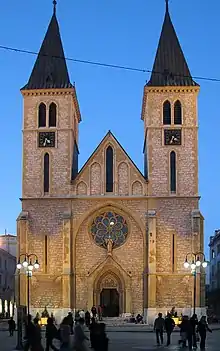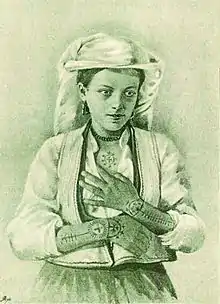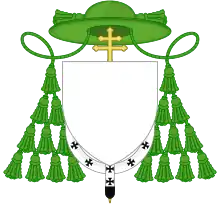Roman Catholic Archdiocese of Vrhbosna
The Archdiocese of Vrhbosna is an ecclesiastical territory or diocese of the Catholic Church in eastern Bosnia and Herzegovina. Its episcopal see is the city of Sarajevo (Vrhbosna), capital of Bosnia and Herzegovina. The Diocese of Skopje is a suffragan of the Archdiocese.
Archdiocese of Vrhbosna Archidioecesis Vrhbosnensis o Seraiensis Vrhbosanska nadbiskupija | |
|---|---|
 | |
| Location | |
| Country | Bosnia and Herzegovina |
| Ecclesiastical province | Sarajevo |
| Statistics | |
| Area | 22,400 km2 (8,600 sq mi) |
| Population - Total - Catholics (including non-members) | (as of 2017) 1,850,000[1] 154,720[1] (8.3%) |
| Parishes | 153[1] |
| Information | |
| Denomination | Catholic |
| Sui iuris church | Latin Church |
| Rite | Roman Rite |
| Established | 11th century |
| Cathedral | Sacred Heart Cathedral |
| Patron saint | Sacred Heart |
| Secular priests | 165[1] |
| Current leadership | |
| Pope | Francis |
| Archbishop | Vinko Puljić |
| Coadjutor | Tomo Vukšić |
| Suffragans | Franjo Komarica, Ratko Perić |
| Vicar General | Slađan Ćosić |
| Archdeacons | The Very Rev. Ilija Miškić The Very Rev. Mato Zovkić Msgr. Bosiljko Rajić Msgr. Ante Meštrović |
| Map | |
 Archdiocese of Vrhbosna (blue) | |
| Website | |
| vrhbosanska-nadbiskupija.org | |
Vrhbosna's cathedral is the Cathedral of the Sacred Heart in Sarajevo. Cardinal Vinko Puljić currently serves as the archbishop of the archdiocese. Tomo Vukšić serves as the coadjutor archbishop.
History

The Diocese of Bosnia (Latin: Dioecesis Bosniensis) existed in Bosnia between the 11th and 15th centuries, and remained as a single title until 1773[2][3] when it was given to the Bishop of Sirmia.

| Part of a series on the |
| Catholic Church in Bosnia and Herzegovina |
|---|
 |
|
It is not known precisely when the Bosnian diocese was established. Based on a collection of historical documents Provinciale Vetus, published in 1188, which mention it twice, once subordinated to the Archdiocese of Split, and another time under the Archdiocese of Ragusa, it is assumed that it came into existence between 1060 and 1075.[4] During the 12th century, it was contested between those two archdioceses as well as another two, the Archdiocese of Antivari and the Archdiocese of Kalocsa.[5] In 1244, an endowment of the parishes of Đakovo and Blezna by King Bela IV of Hungary listed the other parishes of the diocese, namely Vrhbosna, Neretva, Lepenica, Vidgossa (Viduša), Mile (near today's Visoko), Lašva, Uskoplje, Brod (near today's Zenica), Borač (near today's Rogatica).[6][7]
In the 13th and 14th centuries, the Bishops of Bosnia were mainly Dominican missionaries who were sent in to combat the spread of the Bosnian Church.[8] At the turn of the 14th century, the Franciscans also arrived with the same purpose, at first in Usora and Soli, at the request of Stephen Dragutin of Serbia.[9] The two orders engaged in a prolonged dispute over the control of the province, in which the Franciscans ultimately prevailed, yet the weakened diocese still succumbed to the Ottoman conquest of Bosnia in 1463.[10]
During the Ottoman occupation, the bishop of Bosnia had no effective control over the territory of Bosnia, rather, the Franciscan Province of Bosna Srebrena remained the primary vessel of Catholicism in the area. In 1735, the Holy See founded the Apostolic Vicariate for Bosnia, and assigned Franciscans as apostolic vicars to direct it, thereby formally ending the jurisdiction of this diocese over Bosnia.
In 1773,[2] pope Clement XIV united formally the diocese with the Diocese of Syrmia on demand of the Holy Roman Empress and Queen of Hungary and Croatia, Maria Theresa. The 1773 change subordinated it to the Archdiocese of Zagreb. In 1881, the Archdiocese of Vrhbosna was erected, that included the actual territory of Bosnia. The Diocese of Bosnia (Ðakovo) and Srijem became the present-day Archdiocese of Ðakovo-Osijek.[11]
On 5 July 1881, Pope Leo XIII issued Ex hac augusta Principis Apostolorum cathedra, a bull by which he restored the regular Church hierarchy in Bosnia and Herzegovina. With the restoration, both vicariates, the Bosnian (1735–1881) and the Herzegovinian (1846–81) were abolished.[12]
The old Diocase of Bosnia was elevated as the Archdiocese of Vrhbosna.[13] The pope subordinated to it three other dioceses: the newly established Diocese of Banja Luka, the already existing Diocese of Trebinje-Mrkan (under the apostolic administration from the bishop of Dubrovnik at the time) and the Diocese of Mostar-Duvno, to which he added the title of bishop of Duvno as well. The Diocese of Mostar-Duvno encompassed the territory of the Apostolic Vicariate of Herzegovina, which was abolished.[14]
The Apostolic Vicar of Bosnia Paškal Vuičić was simply retired after the abolishment of the vicariate, while the Apostolic Vicar of Herzegovina Paškal Buconjić was appointed Bishop of Mostar-Duvno. Josip Stadler was appointed the Archbishop of Vrhbosna and Administrator of Banja Luka.[15]
The Bosnian War, which resulted in the Siege of Sarajevo on the archdiocese's home, gravely impacted the archdiocese. In the war's aftermath, repairs had to be completed to many damaged churches and chapels. The biggest struggle has been the exodus of Croats, causing the Catholic population in the diocese to drop to less than half of what it was before the conflict.
References
- "Statistike za 2017. | Katolički tjednik". Retrieved 20 November 2018.
- "Diocese of Bosnia (Bosna)" Catholic-Hierarchy.org. David M. Cheney. Retrieved February 29, 2016
- "Metropolitan Archdiocese of Đakovo–Osijek" GCatholic.org. Gabriel Chow. Retrieved February 29, 2016
- OŠJ 1975, p. 134.
- Napredak 1998, pp. 718–736.
- OŠJ 1975, p. 334.
- Napredak 1998, pp. 747–751.
- Šanjek 1996, p. 54.
- Napredak 1998, p. 755.
- OŠJ 1975, p. 370.
- "Archdiocese of Ðakovo-Osijek". Catholic-Hierarchy.org. David M. Cheney. Retrieved 21 January 2015.
- Džaja 2002, p. 49.
- Vrankić 2016, p. 113.
- Vrankić 2016, p. 114.
- Džaja 2002, pp. 49–50.
Sources
- Opći šematizam Katoličke crkve u Jugoslaviji 1974 (in Croatian). Zagreb: Bishops' Conference of Yugoslavia. 1975.
- Povijest Bosne i Hercegovine od najstarijih vremena do godine 1463 (in Croatian). I. Sarajevo: HKD Napredak. 1998.
- Šanjek, Franjo (1996). Kršćanstvo na hrvatskom prostoru. Pregled religiozne povijesti Hrvata (7.-20. st.) (in Croatian). Zagreb: Kršćanska sadašnjost.
Ordinaries
| Archbishop of Vrhbosna | ||||
|---|---|---|---|---|
| From | Until | Incumbent | Notes | |
| 1881 | 1918 | Josip Stadler | Elected in September and confirmed in November 1881, consecrated on 20 November 1881. Died in office on 8 December 1918. | |
| 1922 | 1960 | Ivan Šarić | Appointed Auxiliary Bishop of Vrhbosna on 8 April 1908 and consecrated on 28 May 1908. Appointed Archbishop of Vrhbosna on 2 May 1922. Died in office on 16 July 1960. | |
| 1960 | 1970 | Marko Alaupović | Appointed Auxiliary Bishop of Vrhbosna on 21 May 1950 and consecrated on 24 September 1950. Appointed Archbishop of Vrhbosna on 7 September 1960. Resigned on 13 January 1970 and died on 8 April 1979. | |
| 1970 | 1976 | Smiljan Franjo Čekada | Appointed Auxiliary Bishop of Vrhbosna on 6 June 1939 and consecrated on 6 August 1939. Translated to Skopje on 18 August 1940. Appointed Coadjutor Archbishop of Vrhbosna on 12 June 1967. Succeeded Archbishop of Vrhbosna on 13 January 1970. Died in office on 16 July 1976. | |
| July 1976 | June 1977 | Sede vacante | ||
| 1977 | 1990 | Marko Jozinović | Appointed Archbishop of Vrhbosna on 27 June 1977 and consecrated on 23 October 1977. Resigned on 19 April 1990 and died on 11 August 1994. | |
| 1990 | present | Vinko Cardinal Puljić | Formerly Priest of Banja Luka. Appointed Archbishop of Vrhbosna on 19 November 1990 and consecrated on 6 January 1991. Elevated to Cardinal on 26 November 1994. Participated on Conclave 2005 and Conclave 2013. | |
| Sources:[1][2][3][4][5][6] | ||||
Auxiliary Bishops of Vrhbosna
| Auxiliary Bishops of Vrhbosna | ||||
|---|---|---|---|---|
| From | Until | Incumbent | Notes | |
| 1897 | 1898 | Anton Bonaventura Jeglič | Appointed in August 1897, consecrated on 12 Sep 1897. Translated to Ljubljana in March 1898. | |
| 1908 | 1922 | Ivan Šarić | Appointed Auxiliary Bishop of Vrhbosna on 8 April 1908 and consecrated on 28 May 1908. Appointed Archbishop of Vrhbosna on 2 May 1922. | |
| 1939 | 1940 | Smiljan Franjo Čekada | Appointed Auxiliary Bishop of Vrhbosna on 6 June 1939 and consecrated on 6 August 1939. Translated to Skopje on 18 August 1940. | |
| 1950 | 1960 | Marko Alaupović | Appointed Auxiliary Bishop of Vrhbosna on 21 May 1950 and consecrated on 24 September 1950. Appointed Archbishop of Vrhbosna on 7 September 1960. | |
| 1970 | 1986 | Tomislav Jablanović | Appointed Auxiliary Bishop of Vrhbosna on 16 November 1970 and consecrated on 8 April 1971. Died in office on 10 September 1986. | |
| 1993 | 2019 | Pero Sudar | Appointed Auxiliary Bishop of Vrhbosna on 28 May 1993 and consecrated on 7 January 1994. Resigned on 18 October 2019. | |
| Sources:[2][3][4][5][7][8][9] | ||||
Administrative division
| Archdeaconry | Deaneries |
|---|---|
| Fojnica | |
| Kreševo | |
| Rama | |
| Sarajevo | |
| Sutjeska | |
| Guča Gora | |
| Bugojno | |
| Travnik | |
| Žepče | |
| Plehan | |
| Derventa | |
| Tuzla | |
| Usora | |
| Tolisa | |
| Brčko | |
| Dobor | |
| Šamac |
Saints, Blesseds & Venerables of Vrhbosna
- Drina Martyrs - the professed Sisters of the Congregation of the Daughters of Divine Charity, murdered because of their faith in Bosnia and Hercegovina between December 15 and 23, 1941.
- Josip Stadler, Servant of God - the first modern archbishop of Vrhbosna and the founder of the religious order of the Servants of the Infant Jesus. The process for his canonization began in Sarajevo on June 20, 2002.
- Petar Barbarić, Servant of God - Jesuit seminarian
See also
- Drina Martyrs
- Roman Catholicism in Bosnia and Herzegovina
References
- "Archbishop Josef Stadler". Catholic-Hierarchy.org. David M. Cheney. Retrieved 21 January 2015.
- "Archbishop Ivan Šarić". Catholic-Hierarchy.org. David M. Cheney. Retrieved 21 January 2015.
- "Archbishop Marko Jozinović". Catholic-Hierarchy.org. David M. Cheney. Retrieved 21 January 2015.
- "Archbishop Smiljan Franjo Cekada". Catholic-Hierarchy.org. David M. Cheney. Retrieved 21 January 2015.
- "Archbishop Marko Alaupovic". Catholic-Hierarchy.org. David M. Cheney. Retrieved 21 January 2015.
- "Vinko Cardinal Puljic". Catholic-Hierarchy.org. David M. Cheney. Retrieved 21 January 2015.
- "Bishop Pero Sudar". Catholic-Hierarchy.org. David M. Cheney. Retrieved 21 January 2015.
- "Archbishop Antonio Bonaventura Jeglič". Catholic-Hierarchy.org. David M. Cheney. Retrieved 21 January 2015.
- "Bishop Tomislav Jablanovic". Catholic-Hierarchy.org. David M. Cheney. Retrieved 21 January 2015.
External links
- Herbermann, Charles, ed. (1913). . Catholic Encyclopedia. New York: Robert Appleton Company.

